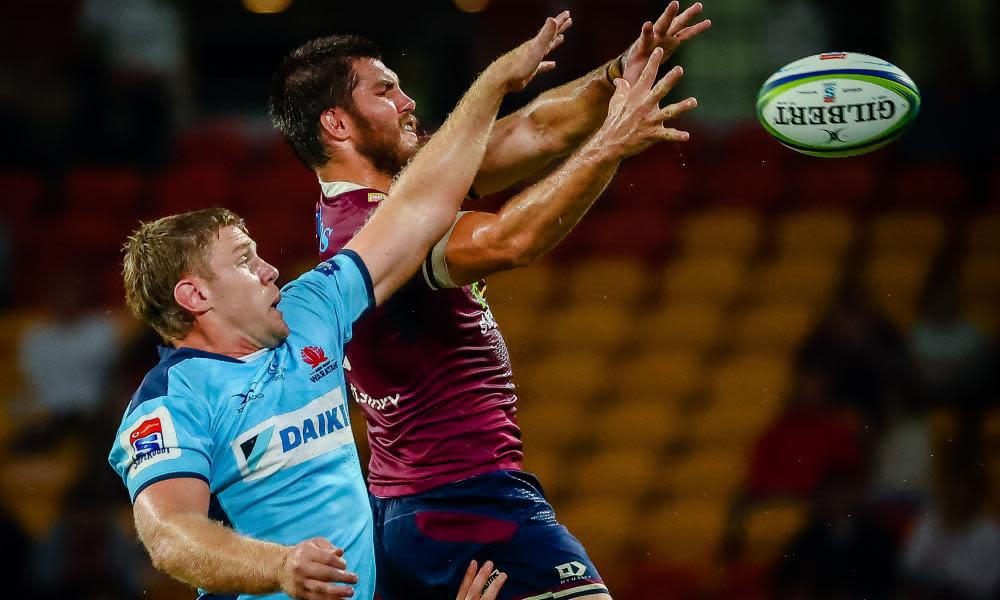Super Rugby AU debut highlights New Zealand's ascendancy

Super Rugby teams from Australia and New Zealand are not only playing in different competitions, they are in different leagues. With Super Rugby AU kicking off at the weekend, it was apparent the Kiwis are still in a league of their own, the gap in standard between Australian and New Zealand rugby as wide as ever.
Sure, the Kiwis got the jump on Australia with Super Rugby Aotearoa starting a month ago, but the game in New Zealand is played at with better skill execution and at a higher intensity.
There were certainly some things to like about Australia’s opening round, particularly the enthusiasm of the Queensland Reds in their drought-breaking 32-26 win against traditional rivals the NSW Waratahs. It was obvious the Reds’ win meant something to the players, which was important, because that kind of passion can transfer to fans sitting in the grandstand and in front of televisions. There were also some outstanding individual performances, notably those of Reds halfback Tate McDermott and Waratahs fullback Jack Maddocks.
It was a similar story in Canberra with the Brumbies withstanding a late comeback by the Melbourne Rebels in a fairly dour contest. Once again, there were some encouraging individual efforts, such as that of promising Brumbies five-eighth Noah Lolesio. But the overall standard of play in Australia is still lagging behind New Zealand, raising questions about the future relationship of the two countries at the provincial level.
Australian officials attempted to jazz up the domestic competition with the introduction of several law variations, but rule changes are not the answer to Australian rugby’s problems. Instead of borrowing rules from rugby league such as the 22-50 rule, which is effectively a 40-20, Australia should be focusing on improving the standard of play, which will drive the game forward. Australia cannot afford the gap with New Zealand to continue to widen or the game in this country will fall further behind and that could have serious ramifications for the future.
Related: Super Rugby borrows from NRL to liven up competition with new rules
New Zealand is pondering what Super Rugby-type format it will adopt next year and Australia is not necessarily in the frame. Australian officials are desperate for a Trans-Tasman competition involving five Australian and five New Zealand teams, not only to prepare players for the Wallabies, but to drive up the value of the next broadcast deal with Fox Sports. But at the moment the Kiwis are keeping an “open mind” in regards any future competition, including a Trans-Tasman, or extending the number of New Zealand teams in Super Rugby Aotearoa.
Significantly, the NZRU believes the five-team Kiwi Super Rugby competition is “unsustainable” because there are not enough teams. If the Kiwis think their five-team competition is unsustainable, where would that leave Australia’s Super Rugby sides if there was no Trans-Tasman rivalry?
Unrestricted by the Covid-19 pandemic, Super Rugby Aotearoa games have attracted bumper crowds. In contrast, 20,000 fans were permitted to attend Suncorp Stadium for the Reds-Waratahs game, but only 5,600 turned up. That same game attracted only 69,000 viewers to Fox Sports, compared to the combined audience of 747,000 on Fox and Nine for the Parramatta Eels-North Queensland Cowboys fixture.
You would have to think Super Rugby AU will become unsustainable too. So what is Australia’s Plan B?
A five-team Australian competition would not be sufficient to sustain the game because it would not provide enough content for a broadcaster or enough gate-money for the franchises. Fox Sports is reportedly paying only $8 to $9m for Australian rugby this season. Even if the broadcaster forked out $15m to $18m next year, it would still not be enough to prevent a mass exodus of players to Europe and Japan, which would reduce Super Rugby AU to a glorified National Rugby Championship. Without a sustainable Super Rugby competition, Australia could focus on the premier Sydney and Brisbane club competitions, which would provide enough content for a broadcaster, but may not provide enough talent to meet Australian rugby’s high performance objectives.
Australia’s four Super Rugby teams could always join the Western Force in mining magnate Andrew “Twiggy” Forrest’s Global Rapid Rugby, which involves teams from Asia and the Pacific Islands. Would that meet Australia’s needs? I am not sure.
But perhaps the Kiwis would not be overly concerned about playing Australia’s Super Rugby teams even if they were not as competitive as the New Zealand sides. All Blacks halfback Aaron Smith stated recently the intense and physical New Zealand local derbies were beginning to take their toll on the players. New Zealand officials really do not want their players, particularly All Blacks, banging each other up every week in a high intensity competition for fear of incurring injuries. The odd, easy game would be a relief.
Ironically, that might work in Australia’s favour when the New Zealanders consider whether or not to play in a Trans-Tasman competition next year. Australian teams may not be in the same league as the Kiwis, but they need to be in the same competition.

 Yahoo News
Yahoo News 
